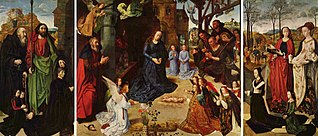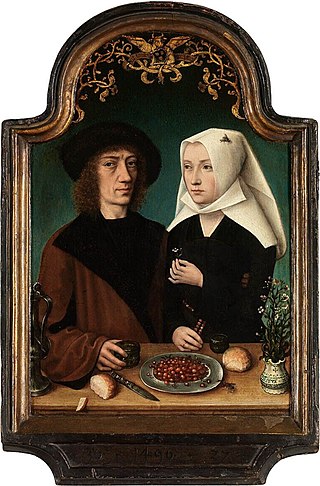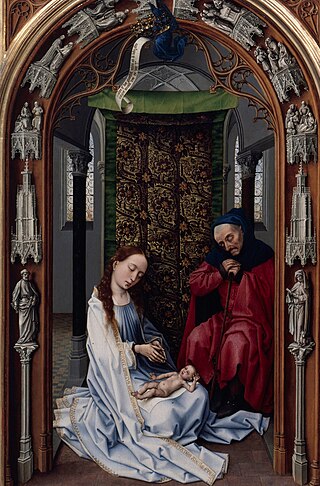
The Torgauer Altar, Torgau Altarpiece or Altarpiece of the Holy Kinship is a triptych altarpiece painted by Lucas Cranach the Elder in 1509. [1]

The Torgauer Altar, Torgau Altarpiece or Altarpiece of the Holy Kinship is a triptych altarpiece painted by Lucas Cranach the Elder in 1509. [1]

The painting includes Joseph, the Virgin, Anna and the child Christ, with Anna's three husbands in the background of the centre panel. The "Holy Kinship" is shown resting in a lavishly decorated room, including marble columns and stone benches. [2]
The three men depicted in the gallery have been identified as having the likenesses of Emperor Maximilian (centre), Imperial Councillor Sixtus Oelhafen (right) and the artist (left). [2]
Unusually, Lucas Cranach signed and dated the painting in Latin: LUCAS CHRONUS/FACIEBAT/ANNO 1509, visible in the notice hanging on one of the central columns. It is suggested that the choice and treatment of the subject shows that he knew the St Anne altarpiece by Quinten Metsys while still in the master's Antwerp studio. Cranach chose an explicitly German theme by means of the forested and mountainous landscape in the background, and including portraits of Emperor Maximilian, Elector Frederick the Wise and his brother, Duke John the Steadfast, among members of the Holy Family. He later painted another version of the Kinship on a single panel. [3]
The triptych was purchased by the Städel Museum Frankfurt in 1906 at auction in Paris. [2]

Lucas Cranach the Elder was a German Renaissance painter and printmaker in woodcut and engraving. He was court painter to the Electors of Saxony for most of his career, and is known for his portraits, both of German princes and those of the leaders of the Protestant Reformation, whose cause he embraced with enthusiasm. He was a close friend of Martin Luther. Cranach also painted religious subjects, first in the Catholic tradition, and later trying to find new ways of conveying Lutheran religious concerns in art. He continued throughout his career to paint nude subjects drawn from mythology and religion.

Matthias Grünewald was a German Renaissance painter of religious works who ignored Renaissance classicism to continue the style of late medieval Central European art into the 16th century. His first name is also given as Mathis and his surname as Gothart or Neithardt.

Robert Campin, now usually identified with the Master of Flémalle, was the first great master of Early Netherlandish painting. While the existence of a highly successful painter called Robert Campin is relatively well documented for the period, no works can be certainly identified as by him through a signature or contemporary documentation. A group of paintings, none dated, have been long attributed to him, and a further group were once attributed to an unknown "Master of Flémalle". It is now usually thought that both groupings are by Campin, but this has been a matter of some controversy for decades.
Michiel Coxie the Elder, Michiel Coxcie the Elder or Michiel van Coxcie, Latinised name Coxius, was a Flemish painter of altarpieces and portraits, a draughtsman and a designer of stained-glass windows, tapestries and prints. He worked for patrons in the principal cities of Flanders. He became the court painter to successively Emperor Charles V and King Philip II of Spain.

The Portinari Altarpiece or Portinari Triptych is an oil on wood triptych painting by the Flemish painter Hugo van der Goes, commissioned by Tommaso Portinari, representing the Adoration of the Shepherds. It measures 253 x 304 cm, and is now in the Galleria degli Uffizi in Florence, Italy. This altarpiece is filled with figures and religious symbols. Of all the late fifteenth century Flemish artworks, this painting is said to be the most studied.

Joos van Cleve was a leading painter active in Antwerp from his arrival there around 1511 until his death in 1540 or 1541. Within Dutch and Flemish Renaissance painting, he combines the traditional techniques of Early Netherlandish painting with influences of more contemporary Renaissance painting styles.

The Holy Kinship was the extended family of Jesus descended from his maternal grandmother Saint Anne from her trinubium or three marriages. The group were a popular subject in religious art throughout Germany and the Low Countries, especially during the late 15th and early 16th centuries, but rarely after the Council of Trent. According to medieval tradition, Saint Anne, the mother of the Virgin Mary, was grandmother not just to Jesus but also to five of the twelve apostles: John the Evangelist, James the Greater, James the Less, Simon and Jude. These apostles, together with John the Baptist, were all cousins of Jesus.

The Master of the Morrison Triptych is the name given to an unknown Early Netherlandish painter active in Antwerp around 1500-1510. He is named for the Morrison Triptych, now in Toledo, Ohio, United States, which is described below.

The Master of Frankfurt was a Flemish Renaissance painter active in Antwerp between about 1480 and 1520. Although he probably never visited Frankfurt am Main, his name derives from two paintings commissioned from patrons in that city, the Holy Kinship in the Frankfurt Historical Museum and a Crucifixion in the Städel museum.

Jan de Beer, formerly known as the Master of the Milan Adoration was a Flemish painter, draughtsman and glass designer active in Antwerp at the beginning of the 16th century. He is considered one of the most important members of the loose group of painters active in and around Antwerp in the early 16th century referred to as the Antwerp Mannerists. Highly respected in his time, he operated a large workshop with an important output of religious compositions.

Colijn de Coter was an early Netherlandish painter who produced mainly altarpieces. He worked primarily in Brussels and Antwerp. His name was sometimes given as Colijn van Brusele, indicating that he hailed from Brussels or at least that he lived there most of his active life. He also signed several paintings with Coliin de Coter pinxit me in Brabancia Bruselle.

The Miraflores Altarpiece is a c. 1442-5 oil-on-oak wood panel altarpiece by the Early Netherlandish painter Rogier van der Weyden, in the Gemäldegalerie, Berlin since 1850. The three panels are each 71 x 43 cm and show, from left to right, a portrait of the Holy Family, a Pietà and Christ's appearance to Mary—a chronological reading of the birth, death and resurrection of Jesus, with Mary the focus of both wings. The altarpiece examines Mary's relationship with Christ at different stages of his life. It is notable for its use of colour, distinguished by its use of whites, reds and blues, and use of line—notably the line of Christ's body in the central panel—and, typically of van der Weyden, its emotional impact.

Sophie of Mecklenburg, also spelled Sophia was a German noblewoman. She was a Duchess of Mecklenburg by birth and by marriage Electoral Princess of Saxony.

The Heller Altarpiece was an oil on panel triptych by German Renaissance artists Albrecht Dürer and Matthias Grünewald, executed between 1507 and 1509. The artwork was named after Jakob Heller, who ordered it. Dürer painted the interior, Grünewald the exterior.

The St John Altarpiece is a large oil-on-oak hinged-triptych altarpiece completed around 1479 by the Early Netherlandish master painter Hans Memling. It was commissioned in the mid-1470s in Bruges for the Old St. John's Hospital (Sint-Janshospitaal) during the building of a new apse. It is signed and dated 1479 on the original frame – its date of installation – and is today still at the hospital in the Memling museum.
Christian Goller was a German painter and trained art restorer who was under investigation by German authorities regarding a number of paintings attributed to Lucas Cranach the Elder. Goller has participated in art restoration courses at the Stuttgart Art Academy. He has restored church altarpieces.

Cupid complaining to Venus is an oil painting by Lucas Cranach the Elder. Nearly 20 similar works by Cranach and his workshop are known, from the earliest dated version in Güstrow Palace of 1527 to one in the Burrell Collection, Glasgow, dated to 1545, with the figures in a variety of poses and differing in other details. The Metropolitan Museum of Art notes that the number of extant versions suggests that this was one of Cranach's most successful compositions.

Law and Grace is considered one of the most important paintings by Lucas Cranach the Elder. This work, in the collection of the National Gallery in Prague, is one of the two oldest known versions of this theme, and was executed in 1529. It is also called ‘the Prague type’ and provided the model for a series of other paintings including an early 16th-century copy that is also kept in the Prague National Gallery's collection of Old European art. It is the best-known and most influential allegory depicting the fundamental tenets of Luther's reform of the church.

The Prague Altarpiece of Lucas Cranach the Elder portrays the Virgin Mary and female saints was, at the time it was made, the second most important altarpiece in St Vitus Cathedral. The altarpiece was most probably brought to Prague as a commission by Emperor Maximilian I. The reason for this could have been the betrothal of his granddaughter Mary to Louis II of Hungary, the engagement of Ferdinand I and Anna Jagiellon (1515) or the coronation of Mary of Habsburg as Queen of Bohemia (1522). A hundred years later, in 1619, the altarpiece fell victim to Calvinist iconoclasm. The figures of the female saints were cut out of it and its central part was destroyed.
The Votive Painting from Šopka (1530) is the work of an anonymous disciple of Lucas Cranach the Elder, who worked in north-west Bohemia and is referred to by the initials with which he signed his paintings as Master IW. The painting was discovered at the end of the 19th century in the parish church, formerly the Augustinian Monastery Church of St. Laurence in Šopka and is exhibited in the Gallery and Museum of the Litoměřice Diocese.